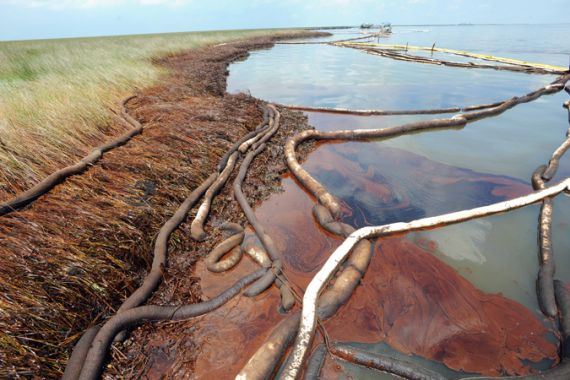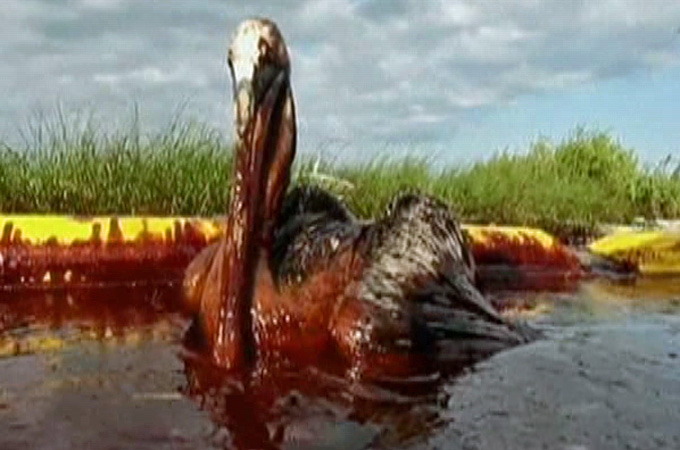‘Risky cuts’ led to US oil disaster
White House commission faults BP and partners for the oil rig blast that led to the worst oil spill in Gulf of Mexico.

Decisions by energy firm BP and its partners intended to save time and money triggered the April explosion that led to the huge oil spill in the Gulf of Mexico, the White House oil spill commission has said.
The commission described systemic problems within the offshore energy industry and government regulators who oversee it, and said a disaster could happen again unless significant reforms are carried out.
Keep reading
list of 4 itemsAfter the Hurricane
World’s coral reefs face global bleaching crisis
Why is Germany maintaining economic ties with China?
In an assessment released on Wednesday, a week before its final report was due, the panel said BP and its collaborators on the Macondo well had lacked a system to ensure their actions were safe.
“Whether purposeful or not, many of the decisions that BP, Halliburton, and Transocean made that increased the risk of the Macondo blowout clearly saved those companies significant time (and money),” the commission said , a week before its final report was due.
An explosion at the Deepwater Horizon offshore rig in April killed 11 people and led to more than 800 million litres of oil spewing from BP’s well.
‘Poor management’
The commission concluded the spill was not an isolated incident caused by “rogue industry or government officials”.
“The root causes are systemic and, absent of significant reform in both industry practises and government policies, might well recur,” the report said.
| In Depth |
 |
But ultimately, the commission blamed poor management for the explosion at the rig, saying that when decisions were made, no one was considering the risk they were taking.
The panel underscores this conclusion with a quote from an email written by Brett Cocales, a BP engineer, just days before the disaster.
“But, who cares, it’s done, end of story, will probably be fine and we’ll get a good cement job,” Cocales wrote, after he disagreed with BP’s decision to use fewer centralisers than recommended.
Centralisers are used to centre the pipe to ensure a good cement job.
The cement failed at the bottom of the Macondo well, allowing oil and gas to enter it, according to investigations.
In another example cited by the commission, a BP request to set an “unusually deep cement plug” was approved by the then Minerals Management Service in 90 minutes. That decision is one of the nine technical and engineering calls the commission said increased the risk of a blowout.
Bob Cavnar, a US oil and gas industry expert, told Al Jazeera that BP had a history of money-saving shortcuts.
“Success really breeds complacency and TransOcean [the firm owning the rig] obviously had a long safety record on this particular rig and BP had a history of corner cutting focusing on profits,” he said.
“And when you have success coupled with getting away with cutting corners, that often times leads to catastrophe just like we saw in this particular instance.”
‘Lessons learned’
BP said on Wednesday that the report, like its own investigation, found the accident was the result of multiple causes, involving multiple companies, but the company was working with regulators “to ensure the lessons learned from Macondo lead to improvements in operations and contractor services in deepwater drilling.”
Kendra Barkoff, the interior department spokeswoman, said the report focused on areas in which the agency in charge of offshore drilling had already made improvements.
 |
| The spill polluted hundreds of kilometres of coastline |
“The agency has taken unprecedented steps and will continue to make the changes necessary to restore the American people’s confidence in the safety and environmental soundness of oil and gas drilling and production on the Outer Continental Shelf, while balancing our nation’s important energy needs,” she said in a statement.
Transocean, which owned the rig being leased by BP to perform the drilling, said in response to the commission’s findings that the “the procedures being conducted in the final hours were crafted and directed by BP engineers and approved in advance by federal regulators.”
Halliburton, the cement contractor on the well, also said it acted at the direction of BP and was “fully indemnified by BP.”
The spill polluting hundreds of kilometres of coastline in all five US Gulf states and triggered a costly clean-up operation. It also harmed fishing and other businesses in the region.
Larry Schweiger, the president and CEO of the National Wildlife Fund, told Al Jazeera that Congress needs to take action and address the issue of liability in offshore drilling developments..
“We have allowed the privatisation of profits by major corporations in offshore oil developments. while we’ve allowed the socialisation of the liability,” he said.
“We’ve transferred to the society the risk of these developments by capping the liabilities at $75 million. That’s incredibly small for such a large disaster as this. it’s probably going to reach somewhere around $16 billion in total liability.”